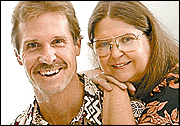Advertisement - Click to support our sponsors.


Health Options
This Sunday, more than 20,000 people will zip, jog, plod, walk, and/or crawl their way over the 26.2 mile course of the Honolulu Marathon. Anyone who has completed a marathon at any pace knows that it puts a major stress on the body. Nutritional guide
for marathonMost everyone "hits the wall" or "bonks" at some point along the long way. These terms are used to describe being so fatigued that the body can't respond to what you are mentally telling it to do.
There are, however, some nutritional measures that can delay or prevent bonking. Those preparing for a marathon know that the first nutritional concern is enough water. Especially in Honolulu, it is virtually impossible to finish a marathon without drinking plenty!
Sweat losses vary greatly from one person to another, from one to three quarts of water per hour. Although it is not essential to replace every drop of sweat lost, excessive loss can result in a medical emergency.
Some marathon runners attempt to store up water the day before the event by drinking great amounts of water. However, the body just passes this extra water into the urine. This also can increase the loss of some important electrolytes like the sodium found in salt.
Most runners lose large amounts of salt in their sweat. Typically, runners have enough salt in their bodies to get through a marathon. However, if salt levels in the body run low, runners can develop a serious condition called hyponatremia (low blood sodium). Those at greatest risk of hyponatremia take longer than four or five hours to finish the marathon.
Low blood sodium causes disorientation, muscle cramps, seizures, even death. Consequently, during the days prior to a marathon the diet should include additional salt. During a marathon, the typical loss of sodium in sweat is equivalent to two to four teaspoons of salt!
During the marathon, both water and a sports beverage are offered to participants. These sports drinks include a carbohydrate energy source, usually in the form of sugars, and a little salt. The carbohydrate in the drink is like high-octane fuel for a marathoner.
When carbohydrate runs low during endurance exercise, the body must burn fat, forcing the runner to slow down. Running low on carbohydrate fuel is thought to be a major cause of hitting the wall. Consequently, most runners load up on carbohydrate before the race to store it away in their muscles.
The sports beverage provided for this year's marathon, like last year, is Amino Vital Water Charge, made by the Ajinomoto Company in Japan. Best known for producing the flavor enhancer monosodium glutamate (MSG), an amino acid, the Ajinomoto Company is the largest producer of purified amino acids in the world.
Water Charge contains fructose for its carbohydrate source, has a low level of salt compared to most American sports drinks and has the unique feature of containing a mixture of amino acids. The purpose of using specific amino acids in sports beverages is to reduce muscle damage and fatigue during exercise and to enhance recovery after exercise. Although the benefit of amino acids in sports drinks is somewhat controversial, supplemental amino acids are a hot research area in sports nutrition.
For those who want to try Amino Vital Water Charge before the Honolulu Marathon, it is available in ABC Stores and some running stores.
Health Events
Joannie Dobbs, Ph.D., C.N.S., is a food and nutrition consultant
and owner of Exploring New Concepts, a nutritional consulting firm.
She is also responsible for the nutritional analyses
indicated by an asterisk in this section.Alan Titchenal, Ph.D., C.N.S., is a sports nutritionist in the
Department of Human Nutrition, Food and Animal Science,
University of Hawaii-Manoa.